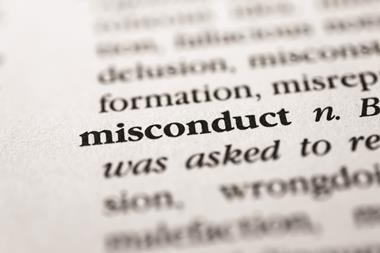New report will move beyond old definitions and promote better working practices
The US National Academies aims to shift thinking about scientific misconduct away from corrupt individuals operating in a vacuum and toward researchers working within a flawed system, in a forthcoming report. The document, more than two years in the making, will offer recommendations to promote research integrity and curb scientific misconduct. It will update an earlier 1992 National Academies report on the topic.
Expected to be completed soon and released this summer, the imminent report was discussed during a session at the American Association for the Advancement of Science’s meeting in San Jose, California on 13 February.
The panel drafting the report is considering issues such as the availability of basic data, complete methodologies and software codes, so as to enable the replication of research findings. Committee member Robert Nerem from the Georgia Institute of Technology said current federal guidelines should be viewed as the ‘minimal’ standard. ‘We all have to do much better than to simply meet what the National Institutes of Health, National Science Foundation or other agencies are requiring,’ he said.
Paul Root Wolpe, a bioethicist and director of Emory University’s Center for Ethics, who also sits on the panel, argued that there was a need to ‘think about the systems involved here and not that if we could just get rid of bad individuals we would solve this problem’. He stressed the importance of addressing whether research institutions and the way in which science is now conducted encourages this abuse.
The National Academies committee is considering expanding the definition of research misconduct, and taking into account the responsibilities of not only researchers, but research sponsors, institutions, scientific journals and professional societies.
Redaction action
Nerem noted that 1.3 million science and engineering research articles were published worldwide in 2013, and of those only 500 scientific papers were retracted. Most of those retractions are purportedly due to research misconduct. ‘That is a small percentage, but it gets the attention of the public,’ Nerem said.
Referencing the highly publicised, serious disclosures of research misconduct in recent years, Nerem asked whether the problem is getting worse or just receiving more attention. The answer remains elusive, panellists agreed.
‘Whatever the case, either the research community addresses these problems, or the government will,’ Nerem warned. ‘As government intervention would not be desirable … then all the stakeholders in the research community need to step up to the plate and upgrade their practices.’
Members of the National Academies committee all agreed that scientific misconduct is underestimated and underreported. To shed light on the topic, Wolpe cited survey data showing that 5% to 33% of scientists have knowledge of a colleague fabricating, falsifying or modifying research data.
Knowledge of wrongdoing
‘That is an extraordinary amount,’ Wolpe stated. ‘If somewhere between 15% and 20% of scientists know of fabricated or falsified research that is implying a much higher rate of scientific misconduct than we normally appreciate.’
When it comes to individual admissions of guilt, about 2% of scientists said they had fabricated, falsified or modified data at least once, according to Wolpe. Considering the thousands of scientists generating more than a million articles on an annual basis this adds up to a significant problem.
A figure commonly quoted to quantify research misconduct is the $58 million (£36 million) cost to the US National Institutes of Health of the retraction of papers owing to misconduct between 1992 and 2012. However, panellists agreed that number is an inadequate barometer. They said it simply captures the costs of retractions, and doesn’t take into consideration all of the other ways in which scientific misconduct costs the research enterprise financially. These include the alienation of scientists and the public, as well as research institutions having to establish committees and oversight processes.
Committee member Brian Martinson, a demographer and social scientist with HealthPartners Research Foundation in Minnesota, presented evidence that the number of scientists admitting engaging in fabrication, falsification or plagiarism over the past three years range from 1% to 8%. The data is based on self-reports, primarily among biomedical researchers.
Other abuses
In addition, Martinson said 10% to 25% of the scientists surveyed admitted to some form of misappropriation, whether of research funds or other people’s ideas. Furthermore, between 14% and 18% of those scientists queried admitted to having circumvented federal regulations in the past three years.
The most recent study that Martinson cited sampled approximately 1000 researchers and postdoctoral students at 40 of the top academic health centres in the US. It found close to half of them admitted to behaviours such as inadequate record-keeping, insufficient monitoring of projects, cutting corners to complete a research project more quickly and circumventing research requirements. Of these researchers, more than half confessed to at least two of them, and nearly a quarter of those admitted to three of the four.
‘Clearly this is not just a one-off thing, this is looking like it is a pattern,’ Martinson stated. Although a far cry from fraud, these activities undermine research and represent ‘a quality assurance issue, not necessarily a crime issue’.












No comments yet